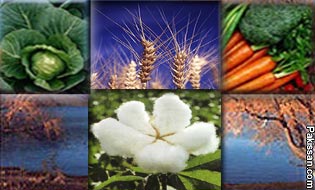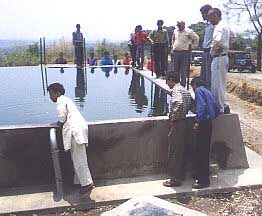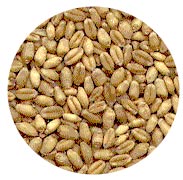|
Strategy for
agriculture sector by on Looker
To translate into projects designed to achieve self
sufficiency, surpluses as raw material for industry and
exports, for reduction in poverty and for creating employment
opportunities.
 --
Agriculture is the mainstay of the country's economy with a
contribution of 24.5% to the GDP. --
Agriculture is the mainstay of the country's economy with a
contribution of 24.5% to the GDP.
-- This sector is, however, faced with some structural and
deep seated problems warranting bold and critical
interventions on many fronts. Some of the issues are as
listed:-
a) Gaps in productivity are far too distinct skewing its tilt
in favour of progressive farmers.
b) Despite horizontal expansion in acreage the yield has
reached a plateau.
c) Farms less than subsistence level are 81 %. The number poor
farmers is on the increase holding lest than 5 acres is 47.5%
of the total farms.
d) Costly inputs and low price of output affect their income.
e) Higher post harvest losses. Cultural practices call for
improvement and more proactive extension out reach.
e) System of research and development warrants revamping and
closer focus for an effective linkage with the farm activity.
FUTURE STRATEGY:
Agricultural strategy is designed to focus on sustainable food
security, higher productivity, import subsidy income
diversification and export orientation. A growth rate of 5% in
the crop sector and 4.6% in the livestock and fisheries sector
is projected for 2004-05.
The main focus to increase productivity of crop is on:
a) Timely sowing with proper technique;
b) Quality seed and optimal plan pipeline level;
c) Judicious and efficient use of inputs;
d) Effective pest management;
e) Market incentives and favourable prices;
f) Larger space for the private sector.
INPUTS IN GENERAL:
-- Raising productivity and profitability level in the farming
sector.
-- Input availability on time through a cost effective
mechanism across the board with a special emphasis on the
small farmer.
-- A system of inventory management would be placed both at
the federal and the provincial levels to closely watch the
supply line and quality of critical inputs for each cropping
season. This should cover seed, fertiliser, pesticides, water
and credit etc.
CREDIT:
-- Major steps are needed in the credit regime. The share of
formal channels lending the farm sector is through on the
increase needs to be doubled over a period.
-- Micro credit network needs rapid expansion.
-- The share of Bank credit to be increased from Rs 65 billion
to Rs 100 billion within two years.
-- Value of land as a collateral for loaning to be up-scaled
by at-least 100% last time it was fixed at Rs 400 for produce
index unit in 1989. The prices of inputs have risen manifold.
This measure will provide more space to the farmers to acquire
more loans on the basis of the same collateral.
-- Special focus to target subsistence and farmers moving less
than 5 acres of land.
-- Rate of interest for agriculture and micro financing should
be gradually brought down. A beginning may be made.
-- Recovery of loan should not be pressed at the harvest time.
-- Liberal credit needs to be funnelled to the livestock
sector through social collateral's.
WATER REGIME:
-- Pakistan is passing through a water stress regime,
impacting heavily on its production system. Effective
conservation strategies need to be put in place by improving
efficiency of water usage. Some useful interventions are
already in place.
 --
Mega project of 86,000 water courses, lining and revamping
will help improve water use efficiency and reduce losses
substantially. --
Mega project of 86,000 water courses, lining and revamping
will help improve water use efficiency and reduce losses
substantially.
-- Execution of this project would require very close
monitoring through latest managerial techniques and devices
like the global positioning system and project management
units. The concept needs skill-full execution.
-- There is a need to harness water resources outside the
Indus System. For the alleviation of poverty in dry areas;
hill torrent water needs to be conserved, diversions and
building of small catchments areas and a distribution system
can help irrigate upto two million hectares through the Rodh
Kohis.
This will also help grow livestock in the range land. It is
estimated to save 50% of 16MAF water available through this
source. It is conceived over seven years at an estimated cost
of over Rs 43 billion. The project is at a preparatory stage
and requires full support.
-- Use of modern methods will be highly encouraged by lending
extension support, improving linkages for adopting techniques
of drip, trickle and sprinkle irrigation.
SEED:
Certified seeds available in the country about 14% in wheat,
60% in cotton 15.5 in paddy and 15% in maize. The seed
renewable target where as is fix 20% for wheat and paddy 100%
for cotton.
 --
Seed is the key determinant of production system. --
Seed is the key determinant of production system.
-- Closer focus on research and development with a view to
diversify varietal base, produce disease resistant, high
quality certified seed.
-- The research out fits to be restructured to give more
financial and administrative space.
QUALITY CONTROL:
-- Quality control mechanism to be made more effective by
upgrading laboratory facilities, improving legal framework
making, quarantine regime more effective.
-- These measures are not only in line with the WTO regime but
will also encourage the process of value addition with regard
to the agricultural produce.
FERTILIZER:
-- There is a need for expansion in manufacturing capacity of
fertiliser.
-- The urea capacity is 4.3 million tones which has reached
the saturation point.
-- The prices of DAP needs rationalisation as the farmers tend
to avoid its use in view of very high price.
-- The GST on fertiliser needs to be withdrawn/reduced.
PESTICIDES:
-- There is a need for a very proactive pest management
campaign with a view to educate the farmers.
-- The Provincial and District Governments should be vigilant
against spurious and fake pesticides.
-- Fully equipped analytical laboratory will be established /
upgraded at Karachi, Lahore, Peshawar and Quetta to ensure
quality control of exportable.
-- Pest scouting should be reinforced.
INCENTIVES:
-- Prices of all other inputs like fertiliser, pesticides,
seeds, farm machinery needs rationalisation by bringing down /
eliminating duties revisiting the sales tax with a view to
give visible relief to the farming community.
-- These incentives will also work as fillip to improve yield
and productivity levels.
-- Mechanisation should be encouraged through an incentive on
the import of farm machinery.
-- Tractor lease financing should be launched at the earliest
at 20% to 25% up front payment.
FARM MECHANISATION:
-- Pakistan's tractors manufacturing capacity is within 35HP
to 85HP. The current production level is 35,000 tractors per
year which far below the requirements. The tractors generation
needs a review with a view to encourage new investors.
-- Import of small tractors below 35 HP with implements in
CBU/CKD may be encouraged for the small farmers at low duty
along-with high efficiency irrigation equipment's as sprinkler
/ drip / trickle system.
CROP SECTOR:
CEREAL:
-- Pakistan's production of cereal crop is round 25 million
tonnes with emphasis on wheat, rice, and to a certain degree
on maize.
-- High growth rate of population creates additional demand of
0.4 million tonnes of wheat each year.
-- Rice is another important food crop in which country is
surplus by 2.5 million tones. It is a source of foreign
exchange earning.
-- Need for varietal development and adoption of hybrid
technology.
-- For mechanical transportation to raise plant density from
.06 million to .1 million.
SUGARCANE:
-- Sugarcane crop is a high water requirement delta crop, at a
level of 15 million acre feet. It is not a competitive
product.
-- As the price of domestic sugar is higher than international
price there is a need value addition, generation of
electricity by sugar mills, providing incentive for
installation of slicing capacity for sugar beet processing.
-- Linking prices to recovery of sugarcane.
-- Timely payment to growers.
COTTON:
-- Cotton is the backbone of the agriculture system. From
procurement of certified seed to the delineating process,
critical interventions are required.
-- We need to up-scale the yield and also to ensure
standardised graded cotton for a ready access for export.
-- Special focus be made on setting up foundation seed cells
in the country. Private sector to be fully encouraged to
participate in this endeavour. Strict regime will be enforced
to control and check the pre release of unapproved varieties
in the market.
-- Pest management at all levels during the season will be
closely monitored with a contingent plan in hand.
-- Favourable support price as a stabilising measure with
favourable market environment will be ensured for a good
return to the grower.
-- Cotton standards will be effectively enforced labs are
being revamped for proper grading and making product
competitive.
-- The role of private sector will be fully encouraged .
-- Bio-safety guidelines are under deliberations with a view
to encourage biogenetic techniques in accordance with our
ecology.
-- Plant breeder's right Act will also work as an incentive
for the private sector to supplement the governments role in
producing quality certified feed.
OIL SEED:
-- It is the largest import item (over $ 800 million of
foreign exchange) after petroleum (meeting 71% requirement).
There is need to accelerate import substitution.
-- There has been a headway in the domestic production in the
production of sunflower, canola and rapeseed mustard.
-- Strategy for the future hinges on technology transfer,
developing linkages between the solvent industry, seed
companies and the farmers. Introducing contract farming,
facilitating quality seed introducing new crops such as oil
palm cultivation coastal areas of Sindh, Balochistan and olive
cultivation in NWFP and Pothohar.
-- There is a close focus on the production of sunflower and
canola in Punjab and Sindh.
LIVESTOCK:
-- Livestock sector has a very rich potential. It consists of
9.3% of the GDP. Its growth can help alleviate poverty in an
effective manner.
-- This sector requires per unit productivity increase through
better feed, proper disease control cover genetic
up-gradation, improved marketing network and liberal credit
line to the farmers.
-- Programmes of artificial insemination needs further
expansion by introducing healthy progenies for producing
healthy animals for meat and mutton.
-- In this sector around 40% margin is appropriated by the
middleman steps need to be taken to have efficient marketing
system to stabilise the price and ensure good return to the
farmers
-- Private sector has moved in the wheat trade through a
liberal credit regime. The role will be encouraged but
speculative trading needs to be guarded against the role of
the private sector.
FISHERIES:
-- An important economic activity along the coast line with
export from its products ranging around Rs 8 billion per
annum, great potential for harvesting.
 --
Deep sea fishing policy is in place. --
Deep sea fishing policy is in place.
-- Focus is on quality fish catch, through on board handling,
proper transportation, training in improved practices.
-- Fish farming being promoted through aquaculture about
40,000 hectares area is already under it.
-- Need for assured credit line to promote this sub sector;
more efforts needed to promote value addition, improve
marketing, strengthen linkages with the private sectors and
prospective investors.
FRUITS AND VEGETABLES:
-- Special efforts will be, made in collaboration with the
Provincial Governments for increasing area and productivity
under export quality fruits and vegetables.
AGRICULTURAL EXPORT:
-- Quality -standard for various produces need to be
implemented faithfully.
-- A shift is to be made from wooden crates to corrugated
carton.
-- Animal and plant quarantine facilities to be upgraded.
-- Liberal incentive to industries involved in vaccine,
grading and packing of fruits and vegetables
POST HARVEST LOSSES:
-- Post harvest losses range from 30% to 40% in fruits and
vegetables.
-- Preserving the quality of fresh produce and processing the
samples will ensure better incentive to the growers.
-- The R&D infrastructure will be strengthened in this regard
with a focus on standardised harvesting and storage
techniques.
-- Cost effective, energy efficient mechanical set up for
dehydration of fruits and vegetables is being developed.
-- Formulation and storage technology for milk and milk
products will be focused upon.
-- Private sector may be encouraged to put up vapour heat
treatment plants to meet the international standards.
-- Laboratories may be upgraded to meet for the necessary
quarantine requirement.
-- Close nexus should developed between the research
institutes and the expert farmer with a view to improve the
quality of the product.
-- National Data Base and information on crops is the need for
the future. This will be an area of close attention.
-- Institutions including the Pakistan Agricultural Research
Council, Pakistan Central Cotton Committee are to be revamped
to tune them to the upcoming challenges.
-- Legal frameworks are being upgraded and improved to cater
for the emergent needs.
Courtesy : Business Recorder
|
Pakissan.com;
|